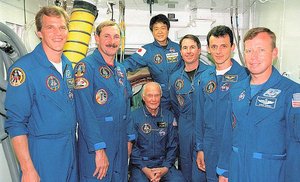STS-95
|
|
This is a mission of the United States Space Shuttle. It marked John Glenn's second space flight, and him breaking the record for oldest person to go into space.
| Space Shuttle program | |
|---|---|
| Mission Insignia | |

| |
| Mission Statistics | |
| Mission: | STS-95 |
| Shuttle: | Discovery |
| Launch Pad: | 39-B |
| Launch: | October 29, 1998 2:20:19 p.m. EST |
| Landing: | November 7, 1998 KSC, 12:04pm EST. Shuttle Landing Facility (SLF) Runway 33. |
| Duration: | 8 days, 21 hours, 44 minutes, 56 seconds |
| Orbit Altitude: | 310 nautical miles (574 km) |
| Orbit Inclination: | 28.45 degrees |
| Distance Traveled: | 3.6 million miles (5.8 million km) |
| Crew photo | |
 L to R: Parazynski, Brown, Glenn, Mukai, Robinson, Duque and Lindsey | Previous Mission: STS-91 |
Next Mission: STS-88 |
| Contents |
Crew
- Curtis L. Brown (5), Commander
- Steven W. Lindsey (2), Pilot
- Scott E. Parazynski (3), Mission Specialist
- Stephen K. Robinson (2), Payload Commander
- Pedro Duque (1), (ESA) Mission Specialist
- Chiaki Mukai (2), (NASDA) Payload Specialist
- John H. Glenn (2), Payload Specialist
Mission Parameters
- Mass:
- Orbiter landing with payload: 103,322 kg
- Payload: 11,130 kg
- Perigee: 550 km
- Apogee: 561 km
- Inclination: 28.45°
- Period: 96 min
Mission Highlights
The primary objectives include conducting a variety of science experiments in the pressurized SPACEHAB module, the deployment and retrieval of the Spartan free-flyer payload, and operations with the HST Orbiting Systems Test (HOST) and the International Extreme Ultraviolet Hitchhiker (IEH) payloads being carried in the payload bay.
The SPACEHAB module being flown on STS-95 is provided by SPACEHAB Inc. a private company which provide single or double module Spacehabs to support NASA's space flight efforts. The SPACEHAB system provides additional pressurized workspace for experiments, cargo and crew activities. SPACEHAB modules have supported various Shuttle science missions along with several of the joint Shuttle-Mir missions.
For STS-95 a single-module SPACEHAB will fly in the forward portion of Discovery's payload bay with the crew gaining access to the module through the airlock tunnel system. A variety of experiments sponsored by NASA, the Japanese Space Agency (NASDA) and the European Space Agency (ESA) will focus on life sciences, microgravity sciences and advanced technology during the flight.
The Spartan 201 free-flyer that will be deployed and retrieved using the Shuttle's mechanical arm and is designed to investigate physical conditions and processes of the hot outer layers of the Sun's atmosphere, or solar corona. While deployed from the Shuttle, Spartan will gather measurements of the solar corona and solar wind. Information collected during this mission will lead to a much better understanding of the solar winds that directly influence orbiting satellites and weather conditions on Earth which in turn impact television and phone communications. This is a reflight of the Spartan payload flown on Mission STS-87 in November 1997 which developed problems shortly after being deployed from the Shuttle.
The Hubble Space Telescope Orbiting Systems Test (HOST) platform is carrying experiments to validate components planned for installation during the third Hubble Space Telescope servicing mission and to evaluate new technologies in an earth orbiting environment. There are four experiments on the HOST platform. The NICMOS Cooling System will allow zero-g verification of a Reverse Turbo Brayton Cycle Cooler which should allow longer life operation than the current dewar system. (2) The HST 486 Computer will allow the identification of any radiation susceptible parts in the DF-224 replacement and demonstrate hardware and software responses to Single Event Upsets (SEU's). (3) Solid State Recorder will compare on-orbit operation of the flight spare solid state recorder with the current HST unit. (4) Fiber Optic Line Test will use the same 4 kbit/s data stream that is sent to the orbiter's Payload Data Interrogator (PDI) and will be routed to a laptop computer for post-flight comparison.
The International Extreme Ultraviolet Hitchhiker (IEH) payload involves a half dozen different experiments mounted on a support structure being carried in Discovery's payload bay. The six experiments that make up the IEH payload are (1) Solar Extreme Ultraviolet Hitchhiker (SEH) payload that will obtain EUV and FUV fluxes that are required when studying the Earth's upper atmosphere; (2) Ultraviolet Spectrograph Telescope for Astronomical Research (UVSTAR) payload designed to measure EUV fluxes which can be used to form images of extended plasma sources (ex. Jupiter, hot stars, etc.); (3) STAR-LITE payload which will make observations of extended and diffused astrophysical targets; (4) CONCAP-IV payload designed to grow thin films via physical vapor transport; (5) Petite Amateur Navy Satellite (PANSAT) payload which is managed by the Department of Defense Space Test Program and involves a small deployable satellite that will store and transmit digital communications to PANSAT ground stations; and (6) a Getaway Special (GAS) payload which is still TBD.
Since the aging process and a space flight experience share a number of similar physiological responses, a series of experiments sponsored by NASA and the National Institute on Aging will be conducted during the STS-95 mission. The investigations will gather information which may provide a model system to help scientists interested in understanding aging. Some of these similarities include bone and muscle loss, balance disorders and sleep disturbances.
Related articles
- Space science
- Space shuttle
- List of space shuttle missions
- List of human spaceflights chronologically
External links
- NASA mission summary (http://science.ksc.nasa.gov/shuttle/missions/sts-95/mission-sts-95.html)
| Previous Mission: STS-91 |
Space Shuttle program | Next Mission: STS-88 |
